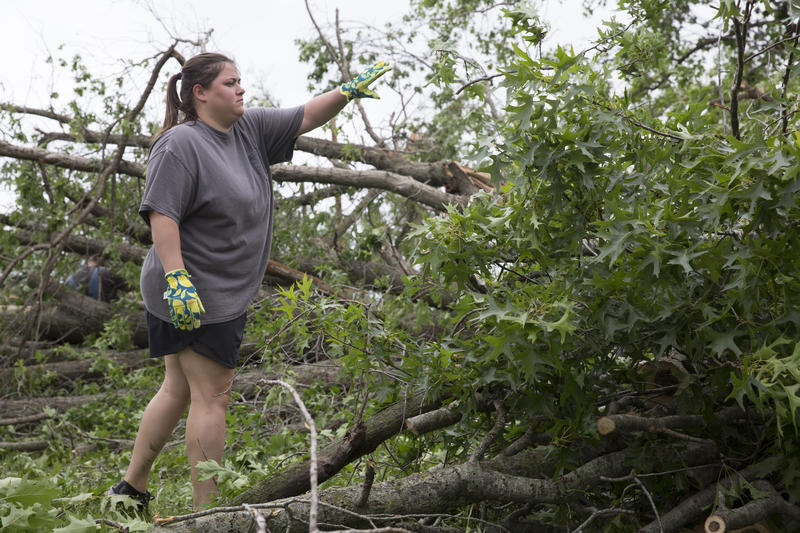
by Nomin Ujiyediin and Scott Canon, Kansas News Service
Katelyn Bossolono clears debris from her yard after the tornado that chewed through Linwood, Kansas. (Photo by Nomin Ujiyediin, Kansas News Service)
With trees shredded into tinder and homes ripped asunder, scores of families in and around Lawrence and Linwood, Kansas, surveyed lives that forever will be marked by the time before and after Tuesday’s tornado.
No one was killed by the powerful twister, surrounded by a mile-wide sheet of rain, that hugged the ground in northeast Kansas for more than an hour. Still, close to two dozen people were injured, including at least one person who needed surgery.
In neighborhoods on the outskirts of towns in Leavenworth and Douglas counties, where the storm leveled its heaviest damage, residents were still unnerved and wondering how long it would take to clear the debris and rebuild.
“It’s going to take a couple of weeks for sure,” said Linwood resident Katelyn Bossolono, whose sheds, barn and car were destroyed by the storm. “Our house is OK and on the inside it’s OK. So overall, I’m doing OK.”
Destruction fell in the usual, seemingly random path left by a tornado, which the National Weather Service preliminarily rated as an EF-4, with wind speeds that appeared to hit 170 mph.
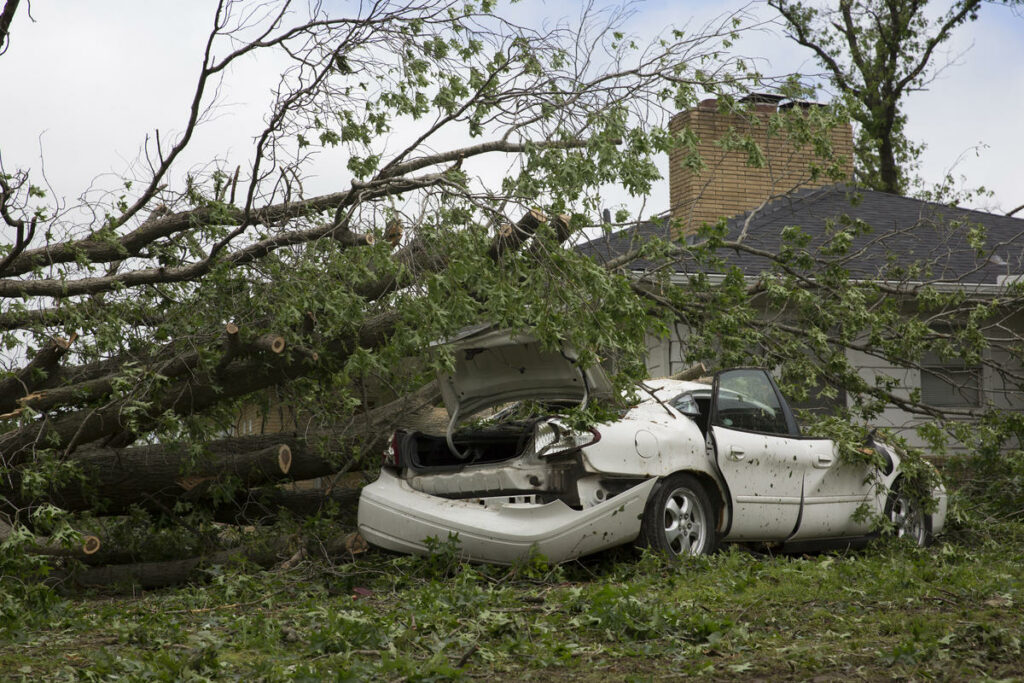
A home torn apart here, a roof tossed aside there and another nearby house inexplicably spared. Toppled trees and other debris clogged state highways and country roads and slowed the chainsaw-and-lift truck chores of restoring electrical power. Housing insulation clung to fences and spread across muddy ground looking like so much dirty cotton candy.
In Leavenworth County, emergency management officials said 50 homes and other structures suffered significant damage, and at least 19 were flattened completely. A landscaping nursery was destroyed.
“We’re still in the initial stage of trying to assess the damage,” said James Fricke, Leavenworth County’s public health emergency preparedness coordinator and public information officer. “We don’t have a dollar estimate yet.”
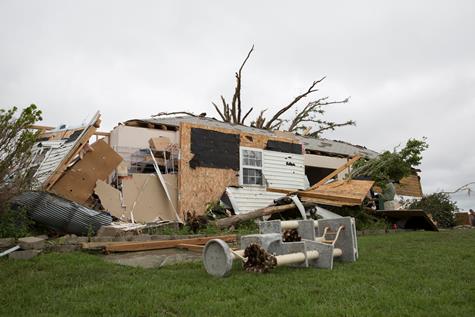
In Douglas County, the sheriff’s office reported that the road conditions (both downed trees and sightseers) made it hard to tally a reliable count of damaged buildings. It estimated significant damage to between 50 and 80 homes.
“We’re still trying to get to all the areas that need our assistance,” Douglas County Sheriff’s Office spokeswoman Jenn Hethcoat, said early Wednesday afternoon.
On a dirt road near a Linwood intersection where nearly every house was damaged, Dena Duffin oversaw cleanup efforts while TV cameras and construction vehicles surrounded her ruined one-story home.
Family members and neighborhood volunteers picked through her house, where the wind had torn off several walls and parts of the roof. The clothes, furniture and books inside were mostly on the floor, drenched and dirty.
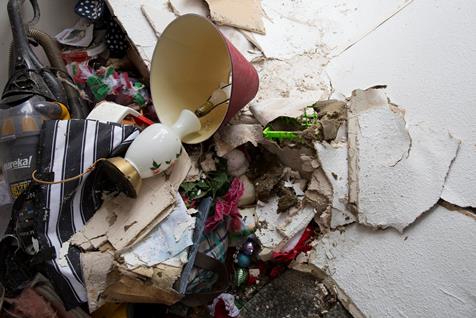
“We have a lot of stuff to go through. A lot of stuff that will just be trashed,” she said. “I don’t even know how to clean it up. I don’t even know where you start with that.”
Duffin, her husband and her two children were unhurt. Her 13-year-old son, Kobee, rescued his pet lizards from a glass tank that managed to survive the storm. But the family still hasn’t found one of its cats, or three of its pet doves.
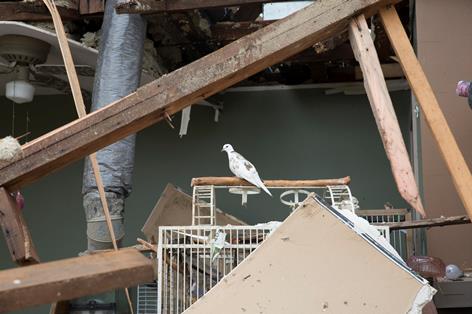
“Whether we rebuild or we move,” said Duffin, “we haven’t quite decided that far.”
At Basehor-Linwood High School, about 15 miles away, volunteers dropped off food and water for storm survivors.
The storm passed by Rodney White’s home in Basehor. A local Facebook group post drew White to the front of the high school, where school staff, firefighters and other community members organized toiletry donations and loaded them onto trucks bound for Linwood.
“We’ve all got family. We all go to school with somebody that was affected by this,” White said. “When your family goes down, you pick them up.”
The National Weather Service assessed the damage on Wednesday and estimated the area was hit by an EF-4 tornado that swirled winds up to 170 mph. It first touched down shortly after 6 p.m. Tuesday in Douglas County, crossed the Kansas River and finally lifted between 7 and 7:10 p.m.
“You typically don’t see tornadoes that strong stay on the ground that long,” NWS meteorologist Matt Wolters said.
To decide the tornado’s rating — the estimated intensity of the winds — teams from the National Weather Service offices in Kansas City and Topeka studied at the path of the twister, where it first touched down and the destruction it left behind.
Eudora resident Kristin Magette told KCUR that her home was largely unscathed, but saw plenty of damage nearby.
“I’ve lived in Kansas for 43 years, and I’ve never confronted the kind of storm that passed right by here,” she said. “I’ve never seen the damage we’re seeing so close to our home.”
Kansas Gov. Laura Kelly planned to tour the storm-battered areas on Thursday.
The Kansas Legislature met in the final day of its 2019 session and passed a resolution that ratified a disaster emergency the governor declared on May 9. Lawmakers extended that emergency through Jan. 13, 2020.
Douglas, Ellsworth, Harper, Leavenworth, Phillips, Russell and Washington counties were added Wednesday to the governor’s state disaster proclamation, bringing the total to 56 counties.
Across Kansas on Tuesday evening, nine tornadoes were spotted in a one-hour spell. Twisters hit Lawrence, Linwood, Eudora and Pleasant Grove. Less severe tornadoes rumbled by Beloit, Bonner Springs, Collier, Russell and Tipton.
National Weather Service forecaster Jon Kurtz told KCUR’s Central Standard that the region was in the middle of an active weather period.
“Tornadoes are just one disaster on top of this massive disaster that has been unfolding for a few weeks now,” he said.
Meanwhile, the state only became more waterlogged and flooding remained a stubborn threat.
The Missouri and Kansas rivers have been running high for weeks. The Arkansas River has spilled from its banks. Reservoirs across Kansas have been releasing torrents of water as they fill to near capacity. Perry Lake and the Toronto Reservoir have been releasing thousands of cubic square feet per second. Releases from the Tuttle Creek Reservoir began on Wednesday.
Late Tuesday, before the tornadoes hit, President Donald Trump agreed to an emergency federal disaster declaration for 18 Kansas counties due to flooding around the state. Kelly said in a statement that, “with additional devastating storms hitting several communities … this may only be the beginning of the support Kansas needs.”
KCUR newscaster/reporter Kyle Palmer and editor Erica Hunzinger contributed to this report.
Nomin Ujiyediin reports out of Topeka for the Kansas News Service, a collaboration of KMUW, Kansas Public Radio, KCUR and HPPR covering health, education and politics. You can send her an email at nomin at kcur dot org, or reach her on @NominUJ.
Scott Canon is managing editor of the Kansas News Service. You can reach him on Twitter @ScottCanon or email scott (at) kcur (dot) org.
Kansas News Service stories and photos may be republished at no cost with proper attribution and a link to ksnewsservice.org.
See more at https://www.kcur.org/post/tornado-whipped-northeast-kansas-170-mph-winds-left-residents-clean
